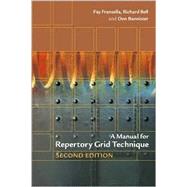
What is included with this book?
Richard Bell is an Associate Professor of Psychology at the University of Melbourne. He is interested practical problems of measurement in clinical, organizational and educational settings. He has written extensively on the analysis of repertory grid data and has authored widely used software for the analysis of such data.
The influence of Don Bannister in arousing interest in George Kelly’s theory and methods of assessment has been profound. Even after his untimely death in 1986 his influence continues, through those he inspired, through his professional research and writings, and also through his four novels. In the year in which this second edition of the Manual for Repertory Grid Techniques is published the 15th International Congress in Personal Construct Psychology was held in Huddersfield, UK, focusing on that outstanding influence. He spent much of his professional life carrying out research for the UK Medical Research Council, which included a year working with George Kelly at Ohio State University in 1965. He saw the psychology of personal constructs as an approach to the person that was empowering, democratic and, above all, valuable in helping people understand themselves and others. He was insistent that psychologists should use what power and influence they have to make a difference in the lives of people. He would have taken great interest in the vast amount of new work that has been carried out with and into that tool which is detailed in this second edition of the book that he co-authored in 1977.
| About the Authors | ix | ||||
| Preface | xi | ||||
| Acknowledgements | xiii | ||||
| 1. The Basis of Repertory Grid Technique | 1 | (14) | |||
|
1 | (4) | |||
|
5 | (1) | |||
|
5 | (2) | |||
|
7 | (2) | |||
|
9 | (3) | |||
|
12 | (1) | |||
|
12 | (1) | |||
|
12 | (3) | |||
| 2. Constructs And Elements | 15 | (39) | |||
|
15 | (1) | |||
|
15 | (3) | |||
|
18 | (5) | |||
|
23 | (4) | |||
|
27 | (3) | |||
|
30 | (9) | |||
|
39 | (7) | |||
|
46 | (3) | |||
|
49 | (1) | |||
|
50 | (1) | |||
|
50 | (2) | |||
|
52 | (2) | |||
| 3. Varieties Of Grid In Use Today | 54 | (28) | |||
|
54 | (1) | |||
|
54 | (2) | |||
|
56 | (3) | |||
|
59 | (6) | |||
|
65 | (5) | |||
|
70 | (3) | |||
|
73 | (3) | |||
|
76 | (2) | |||
|
78 | (1) | |||
|
79 | (1) | |||
|
80 | (2) | |||
| 4. Analyzing Grid Data | 82 | (31) | |||
|
82 | (1) | |||
|
83 | (8) | |||
|
91 | (2) | |||
|
93 | (5) | |||
|
98 | (3) | |||
|
101 | (3) | |||
|
104 | (4) | |||
|
108 | (5) | |||
| 5. Some Summary Measures Of Structure | 113 | (19) | |||
|
114 | (7) | |||
|
121 | (1) | |||
|
122 | (2) | |||
|
124 | (2) | |||
|
126 | (1) | |||
|
127 | (1) | |||
|
128 | (1) | |||
|
129 | (1) | |||
|
130 | (2) | |||
| 6. Reliability and Validity | 132 | (21) | |||
|
132 | (11) | |||
|
143 | (1) | |||
|
143 | (8) | |||
|
151 | (2) | |||
| 7. Specific Ways Of Using Grids | 153 | (15) | |||
|
154 | (8) | |||
|
162 | (1) | |||
|
163 | (4) | |||
|
167 | (1) | |||
| 8. Some Uses To Which Grids Have Been Put | 168 | (62) | |||
|
169 | (1) | |||
|
170 | (18) | |||
|
188 | (4) | |||
|
192 | (3) | |||
|
195 | (1) | |||
|
196 | (3) | |||
|
199 | (5) | |||
|
204 | (6) | |||
|
210 | (1) | |||
|
211 | (1) | |||
|
212 | (1) | |||
|
213 | (2) | |||
|
215 | (2) | |||
|
217 | (1) | |||
|
218 | (1) | |||
|
219 | (1) | |||
|
220 | (1) | |||
|
220 | (6) | |||
|
226 | (4) | |||
| Appendix Computer Programs and Websites | 230 | (2) | |||
| References | 232 | (26) | |||
| Author Index | 258 | (4) | |||
| Subject Index | 262 |
The New copy of this book will include any supplemental materials advertised. Please check the title of the book to determine if it should include any access cards, study guides, lab manuals, CDs, etc.
The Used, Rental and eBook copies of this book are not guaranteed to include any supplemental materials. Typically, only the book itself is included. This is true even if the title states it includes any access cards, study guides, lab manuals, CDs, etc.